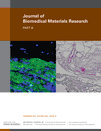In vitro degradation, biocompatibility, and in vivo osteogenesis of poly(lactic-co-glycolic acid)/calcium phosphate cement scaffold with unidirectional lamellar pore structure†
How to cite this article: He F, Ye J. 2012. In vitro degradation, biocompatibility, and in vivo osteogenesis of poly(lactic-co-glycolic acid)/calcium phosphate cement scaffold with unidirectional lamellar pore structure. J Biomed Mater Res Part A 2012:100A:3239–3250.
Abstract
The aim of this study was to investigate the in vitro degradation, cytocompatibility, and in vivo osteogenesis of poly(lactic-co-glycolic acid) (PLGA)/calcium phosphate cement (CPC) scaffold with unidirectional lamellar pore structure. CPC-based scaffold was fabricated by unidirectional freeze casting, and PLGA was used to improve the mechanical properties of the CPC-based scaffold, which covered the surface of the pore wall as coating. The in vitro degradation results demonstrated that the PLGA/CPC scaffold had good degradability. The degradation of PLGA film on the surface of the scaffold made the CPC matrix exposed, which facilitated cell response and osteogenesis. Rat bone mesenchymal stem cells (rMSCs) were seeded on the PLGA/CPC composite scaffold. Cell viability, proliferation, and differentiation on the PLGA/CPC composite scaffold were evaluated. The results showed that viable rMSCs attached on the surface of pore wall gradually penetrated into the internal pores of the scaffold as prolongation of culture time. In addition, the rMSCs seeded on the scaffold exhibited good proliferation and growing alkaline phosphatase activity. The scaffold was implanted in the defects in distal end of femora of New Zealand white rabbits. Histological evaluation indicated that the PLGA/CPC scaffold with unidirectional lamellar pore structure had good biocompatibility and effective osteogenesis. These results suggest PLGA/CPC composite scaffold with unidirectional lamellar pore structure is a promising scaffold for bone tissue engineering. © 2012 Wiley Periodicals, Inc. J Biomed Mater Res Part A 100A:3239–3250, 2012.




